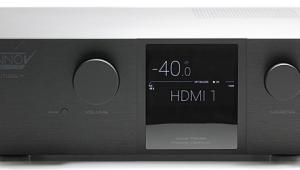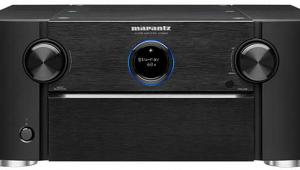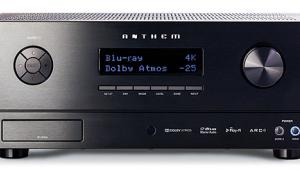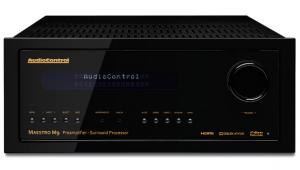Lexicon MC-12 surround-sound processor
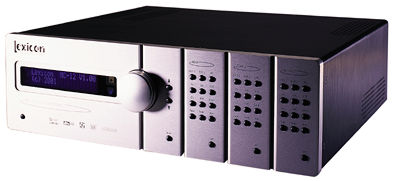
At the same time, even the company's flagship model, the MC-1, now two years old, has begun to show its age. I've owned an MC-1 since 1999, and two major developments in the industry have made it increasingly out of step with its peers—and with customers' needs: It has no component-video switching, and there is no 5.1-channel analog pass-through for Super Audio CD and DVD-Audio. The problem, as Lexicon explained it, was the MC-1's size: There simply was no room on its rear panel for a 6-channel analog input (six RCA jacks), or for three or four component-video inputs plus a component output.
More than a year ago, Lexicon set out to break the mold they'd used since 1996 and produce a large-format device that could accommodate everything left out of its predecessors. Thus was born the MC-12. (The "MC" in these names stands for Music and Cinema; "12" refers to the potential number of channels.) From the outside, the MC-12 bears no resemblance to the long, narrow, black-glass faceplates of the earlier models. It's larger, heavier, and its face is a stylized machined-metal plate that I find appealing. But turn it on, and its heritage is visible right away in the blue front-panel display—the same as is used in the MC-1.
Description
While everything about the Lexicon MC-12 is said to be an improvement over the MC-1, at its heart the MC-12 works just as the earlier versions did. It offers ample flexibility, but the menus are so easy to use that anyone can set up the unit without confusion. In short, it's a winner, though at a significantly heftier price.
The MC-12 comes in two flavors: standard and balanced. The only difference is that the balanced version adds balanced-audio outputs, intended to reduce signal interference and, presumably, hum and noise. The unbalanced version costs $8995; the balanced version is $1000 more and about an inch taller—the balanced outputs are housed in a stylized black base. That makes the MC-12s significantly more expensive than the MC-1, Lexicon's top-of-the-line model until now: $3000 more for the unbalanced model, $4000 more for the balanced. I reviewed the unbalanced version; the balanced model was not available at the time of this review, but should be by now.
For the higher cost you get much a much improved feature set, a richer array of internal components that promise improved performance, and cosmetics intended to be more appealing. "There is a pride of ownership that comes with owning something extraordinary, like a high-performance watch, automobile, or a piece of A/V gear," said Lexicon executive Andy Clark in an interview on Lexicon's website. "People enjoy showing these things off to their friends and family. They expect it to look extraordinary, regardless of how it performs."
The MC-12 does stand out. Its front panel offers the display on the left, just below the company logo—which is machined 1/8 inch deep into the metal. Below the display are labels advertising a few of the processing modes available: Dolby Digital, Dolby Pro Logic II, DTS ES, Lexicon's Logic 7, and THX's Ultra and Surround EX. To the right is a large volume-control knob, then three banks of 12 input buttons each, one bank for each of the three main outputs: Main, Zone 2, and Record. The Main outputs support as many as nine channels, plus three subwoofer outputs, a stereo pair, and a single low-frequency effects channel for use with a single subwoofer. You could, in theory, use three subwoofers. (Two of the 12 outputs are marked Aux and are designated for future use. In fact, no 9.x surround format is yet available.) The outputs for Zone 2 and Record are stereo only.
The MC-12 addresses one complaint about the MC-1: a paucity of subwoofer crossover points. While the MC-1 offered only three—40Hz, 80Hz, and 120Hz—the MC-12 allows you to pick any point between 30Hz and 120Hz, at 10Hz increments.
Also on the back are four microphone inputs. One possible future upgrade, Lexicon says, could be automatic speaker setup using mikes (not included). Unlike the earlier units, the MC-12 can accept software upgrades through an RS-232 port on the back, meaning that the user could connect a PC and download the upgrade.
The 12 inputs are configurable for any type of device, though the front-panel labels anticipate almost anything you might choose to use: DVD 1, DVD 2, LD, TV, Sat, VCR, CD, PVR, Game, Tape, Tuner, and Aux. You can rename the inputs so that the front-panel display shows the name you choose, such as DAT or HDTV. But of course, the buttons' names are unchangeable (unless you want to paste labels over them).
The rear-panel inputs are as numerous as I've seen on almost any processor: five composite video, eight S-video, four component video (including one using BNC jacks), and one 5.1-channel analog input using RCA plugs—with direct analog pass-through available for DVD-A and SACD. There is no bass management in the analog pass-through mode. Those six pass-through jacks are switchable and double as stereo audio inputs. So if you're using them for multichannel SACD or DVD-A, you're left with five stereo audio inputs. In addition, there is an amazing number of digital audio inputs, 13 in all: six coaxial, six optical, and one AES/EBU.
To the far right of the rear panel is a removable plate. Lexicon says that this is for future upgrades—including, most particularly, a 5.1-channel digital input for SACD and DVD-A players. A year ago, Lexicon acknowledged that the company had been banking on an agreement soon for such a digital input. Had it come in time, the DC-2 and MC-1 models could have been upgraded to accommodate that single additional jack. But that was not to be, and no one can say when that agreement will come. As with everything digital these days, it's tangled in copyright concerns.
- Log in or register to post comments

